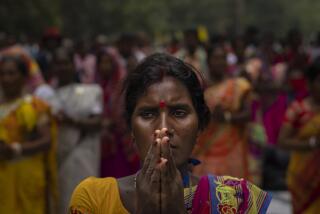India’s Snake Charmers a Dying Breed
MOLARBAND, India — In the land where it was born, the ancient art of snake charming is dying and its half a million practitioners are vanishing.
Hunger haunts them. Police chase them. Ecologists despise them. People on the street no longer care for them.
“Snake charming is no more a paying profession,” 90-year-old Sunder Nath said. “Our children are not interested in snake charming anymore. There is not enough money, not enough charm left.
“Our children want to become clerks, bus drivers, even policemen, but not snake charmers.”
Although he walks with the aid of a stick, Nath still holds roadside shows.
The guru and saint of snake charmers is Gorak Nath, who they say lived 500 years ago, and all snake charmers take his last name.
Molarband, about 20 miles south of New Delhi, is one of the two villages in India exclusively inhabited by snake charmers. The other village is in the state of Orissa, in eastern India.
About 1,500 snake charmers live in Molarband in mud-and-stone homes. Each home has 10 to 15 snakes.
“Gone are the days when our children lived with snakes, grew with snakes,” said Prabhu Nath, 50, whose two children attend a government-run school not far from Molarband. “Now they are going to schools to learn English.”
“When I grow up I would like to become bus driver,” said 15-year-old Rajpal Nath, a ninth-grader. “My friends tell me that snake charming is nothing but another form of begging. I don’t want to be called a beggar.”
“There is no value in our father’s work. We are looked down on by everyone,” added 14-year-old Rameshchand Nath, who wants to be a bank clerk.
About 250 of the 1,500 students at the school near Molarband are from families of snake charmers.
“This is remarkable,” said Ram Lal Longia, the school’s headmaster. “Ten years back, we hardly had any student from the snake charmers’ families.”
Experts say the ranks of India’s 500,000 snake charmers are declining fast.
“There are no new charmers joining the clan. What we have is the old stock,” said Komolesh Dev, who has spent months in Molarband studying the life of the snake charmer.
“There was a time when snake charmers were part of Indian life, they provided the best and cheapest entertainment.
“But today, who cares for them? They are remembered only once a year during the snake festival.”
Every year on Nag Panchimi, or Snake God festival day, Hindus pray to snakes and feed them. The brave among them wear snakes around their necks, and some even pose with them for photographs.
Women make snake beds in their homes and pray to snakes to give them sons.
“Only on that day we are in great demand,” said Sambhu Nath. “We offer our snakes for hire and make good money. But it is only one day of bright sunshine in a year.”
A team of two snake charmers on the average makes about 75 rupees ($5) a day.
“From this amount we bribe the police, feed our snakes and run our families,” Sambhu Nath said.
But there is no business during monsoon season and parts of India’s blistering summer.
The Indian Wildlife Act prohibits the possession, sale or purchase of about 30 of India’s 240 species of reptiles, and the ban includes the king cobra, the most prized possession of a snake charmer.
“You can’t hold a show with rat snake,” Prakash Nath said. “It ought to be a king cobra or at least a cobra. . . . Only then people are interested.
“First, it is difficult to find a cobra because forests are vanishing, and when we find one, we can’t keep it forever, as it is against our tradition.” When a snake charmer decides to catch a snake, he performs a rite and pledges to release it within a year.
More to Read
Sign up for Essential California
The most important California stories and recommendations in your inbox every morning.
You may occasionally receive promotional content from the Los Angeles Times.










